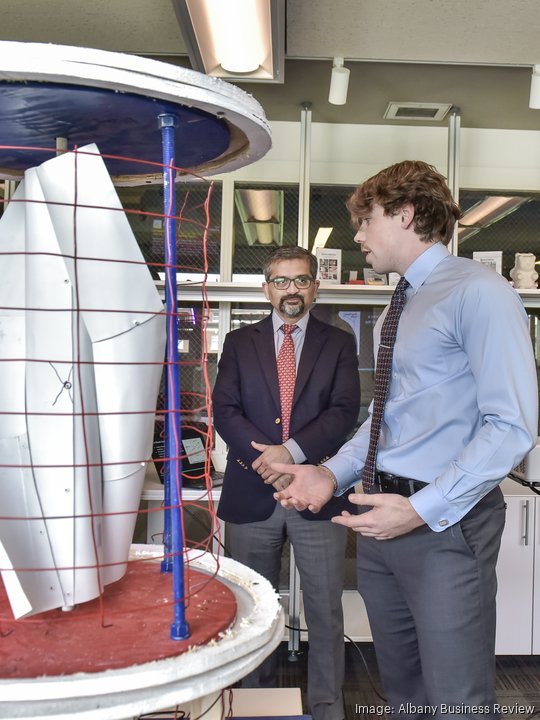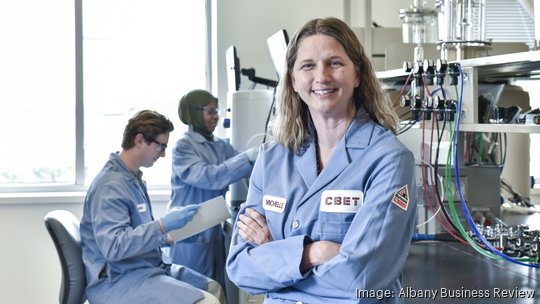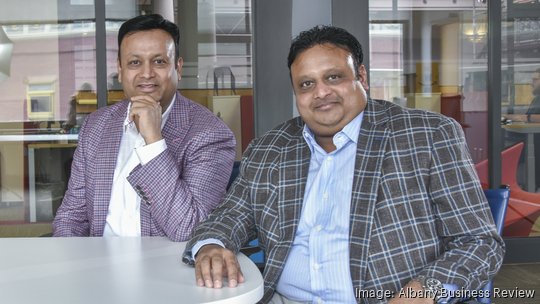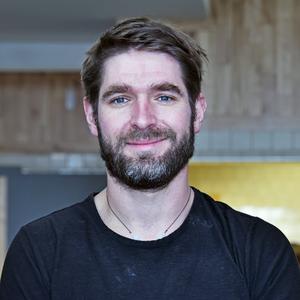Rensselaer Polytechnic Institute’s president, Martin Schmidt, spent the first six months in his new role listening.
In conversations with everyone from local RPI alumni to the CEO of Albany International Airport, he has been gathering feedback from the community.
Schmidt, himself an RPI alumnus, was at the Massachusetts Institute of Technology for 40 years. He’d ascended to the job of provost, the institution’s chief academic and budget officer. During his career, he’s started seven companies and had a front row seat to the development of an internationally recognized cluster of tech companies near the university.
With all that experience, he sees great potential in the Albany region — if people here can learn to work together in meaningful ways.
“When we’re arguing about whether the next opportunity should be in Cohoes, or Troy, or Guilderland ... that’s small ball. That’s really small ball. The leadership in the region needs to be able to think in a less parochial way,” Schmidt said.

Schmidt succeeded Shirley Ann Jackson as president of RPI. She retired last year after 23 years in the job and left the university in a strong financial position, having raised over $2 billion during her tenure.
Jackson also made the controversial decision to close RPI’s startup incubator space, which had helped launch several notable companies. It was replaced with a virtual program.
Vikram Agrawal started the health care IT company Etransmedia Technology with his brother, Vikash, in the incubator in 1999. They grew it to more than 400 people before it was acquired in 2017.
Agrawal said at the time of the incubator’s closure in 2010 that he feared the area would miss out on future economic development opportunities.
“I could not have started my company without the incubator,” Agrawal said then. “This could hurt innovation.”
Since the closure, Agrawal said the collaborative startup ecosystem has diminished. Startups have dispersed across the region, some don’t stay once they’re successful, and the ones that are here don’t know each other.
“Even in downtown Troy, where Vikash and I work and go to the office every day, I don’t know 90% of the companies,” he said. “Being an entrepreneur is a lonely journey. It’s not easy. And when you deal with other peers, when you kind of get to hang out with other entrepreneurs, it fosters a sense of ecosystem.”
Now, over a decade later, Schmidt is talking about reinvigorating RPI’s role in the local startup scene to help foster those connections again.
“That’s sort of the backbone of the strategic plan,” he says. “By seeing the region flourish, you can see those opportunities being created.”

Engage the region
Agrawal believes that RPI has to be the region’s leader in collaboration.
“RPI is the MIT of our area,” he says.
When Martin Schmidt arrived in Cambridge, Massachusetts, in 1981, Kendall Square was empty parking lots, abandoned factories and a diner. It’s now one of the world’s leading centers for biotech research, thanks in part to collaboration between institutions such as Harvard and MIT, which saw potential in the emerging fields of molecular biology and genomics.
So it would be easy to say that Schmidt should take what he learned there about institutional collaboration and innovation ecosystems and copy and paste it here in Albany.
But the Capital Region isn’t Boston. It doesn’t, for example, get billions of dollars in National Institutes of Health funding. Schmidt acknowledges that. But he does see possibility.
“I think what RPI’s role can be is to try and help facilitate the convening of these organizations to think, ‘Where do we want to go?’” he said. “There’s no way you’re going to replicate Kendall Square anywhere else, not in the near term, just because of the density of life scientists in that area.”
But his biotech connections in Boston are facing a challenge: manufacturing their product. He thinks the Albany region can help with that.
Schmidt is fascinated by Regeneron’s manufacturing presence here. He sees a recipe for a biotech manufacturing hub in the Capital Region.
“Somebody [in the Boston area] said to me that, ‘I had to hire 300 scientists in a year, and there was only one place in the world I could do that.’ But when they go into production, it’s challenging to do that in the greater Boston area. And so to me, that’s a real opportunity for the region ... kind of a perfect example of where we can all get together. “
In fact, Schmidt’s already asking company leaders if they’d consider manufacturing in the Albany region. Doing so would build on the workforce already here and help retain talent in the area.
“The conversations I’ve had back in Boston with some of these leaders is: ‘Would you consider putting your plants here versus New Hampshire or wherever?’ And I think they definitely would be on receipt for that,” he said.
Biopharmaceuticals, in particular, are one area where there’s potential for collaboration here.

Michelle Lewis is executive director of the Center for Biopharmaceutical Education and Training at the Albany College of Pharmacy and Health Sciences. Her goal is to grow the pipeline of talent that biopharmaceutical companies can pull from.
The college is already working with Hudson Valley Community College on that pipeline: Students from HVCC can continue their education at the pharmacy college with a scholarship to pursue a master’s degree in biomanufacturing and bioprocessing.
The college also offers a postgraduate fellowship with Curia Global and the Food and Drug Administration involving all three institutions.
Lewis said she sees RPI growing its external relationships as an important development for other higher education institutions in the area.
“I think we have all the pieces here,“ she said. “All of these partners can really leverage each other’s resources and I would encourage everyone to look for ways to partner. I’m a firm believer that teamwork makes the dream work.”
Build the runway
Downtown Troy is currently home to a handful of players in the local innovation economy: The Tech Valley Center of Gravity manufacturing incubator, video game studios like Velan Studios and 1st Playable, software companies like Levrx, and artificial intelligence company Scan2Plan, among others.
It’s part of what sold Martin Schmidt on the opportunity to be RPI’s next president.
Looking forward, Schmidt sees more opportunities with semiconductors. The Albany region already has GlobalFoundries and the research hub at the Albany Nanotech Complex. The federal government is about to pour billions of dollars into the industry, and Albany is a leading candidate for a new semiconductor research center that could bring 1,000 jobs.
“I can see the shoots coming out of the ground. ... Each one of these looks like massive opportunities for really moving the needle for the region,” he said. “Knowing that an institution like RPI can play a central role in driving that, which will have to go well beyond my time as president, but you have to get started, that was one compelling opportunity. “
Pushing the needle further could come in the form of partnering area companies with startups, he said. Traditionally, research was commercialized by transferring industry-sponsored research within universities to a company. But now, larger companies see startups as a way to bring in new innovations.
To facilitate that, Schmidt calls for “building the runway.” It starts on campus, and would likely involve reintroducing an incubator or something similar, he explained during a panel discussion at RPI in April.
Vikash Agrawal, the co-founder of Etransmedia, pointed to companies like Velan Studios and a majority of Troy’s gaming ecosystem, as well as GlobalSpec, MapInfo and Curia Global (formerly Albany Molecular Research Inc.) as evidence that RPI had a successful translational hub before.
“Every major successful technology company in town ... the entrepreneurs had some connections with the incubator center,” he said. “They were young grads when they started. But as they grew older, they built the companies, they progressed.”
Next would be connecting that runway to the rest of the region so graduates have the opportunity to stay here, Schmidt said.
“We should make it possible. Large companies historically have engaged with universities, and RPI enjoys some really strong partnerships with companies like IBM, and GlobalFoundries. And so I think we just have to build the capacity to do that at a larger scale.”
Grow the pipeline from RPI
Another avenue Schmidt sees for more closely engaging RPI with the Albany region is finding more ways to connect graduates with jobs in the area.
The university is well known for providing an education in some of today’s most in-demand subject areas. But many graduates leave for opportunities elsewhere.
For example, computer scientists are highly sought after, and Schmidt says that about 30% of the incoming freshmen class intend to major in the field.
“That suggests that in a little more than three years, RPI is going to be handing out 600 diplomas in computer science from one of the most rigorous computer science curriculums in the country,” he said. “So wouldn’t it be nice if some fraction of them stayed in the Capital Region? And so what are the opportunities we’re going to create for them to do that?”
There is already an extensive network of RPI alumni and associated companies here for graduates to join.
The Agrawals are a prime example. After selling Etransmedia, they started Levrx in downtown Troy. The company makes software that allows patients to more easily shop around for prescriptions.
Companies like Levrx could directly benefit from RPI connecting students with local job opportunities.

“I think RPI has to engage back and figure out how to take advantage of the local software companies because they have a large program and every undergrad has to do a six-month internship as part of the curriculum, so they should take advantage of the local companies and vice versa,” Vikram Agrawal said.
Growing the talent pipeline won’t be the domain of one university. Each institution in the Capital Region has its strengths, and combining those strengths can lead to regional success. At Levrx, Vikram Agrawal said all the engineering talent is from RPI, and employees in finance and marketing come from Siena College.
Michelle Lewis, from the Albany College of Pharmacy and Health Sciences, also sees that pipeline as a group effort. While her programs are focused on building a biomanufacturing workforce, the combined resources of local universities can create a widely skilled group in the region.
“We can move and row in the same direction. We just get stronger and stronger attractiveness to people looking to start new businesses, people wanting to relocate from Boston or New York City or California, [to] where the cost of living is lower. And they have everything they need,” she said.
How he’ll get started
Schmidt said the first step to implementing these regional ideas is to make a plan.
“What we have to do is get everybody together, and then have conversations with the government, local and state, about what can we do as a region to promote it,” Schmidt said.
Greater societal forces could play to the region’s advantage too. Schmidt cited a recent New York Times article reporting that young graduates are leaving America’s largest cities for more affordable urban environments, a phenomenon he sees as another chance for the region to attract people. He’s also optimistic about Albany’s chances to get a piece of the National Semiconductor Technology Center.
To kickstart it all, Schmidt said the university’s bicentennial in 2024 will be the moment to not only reflect on what it has accomplished so far, but also the opportunities that lie ahead.
“There are so many things that are moving in the right direction for this region and, honestly, that was not an insignificant reason for me thinking about this being a nice opportunity for me as the next stage in my career.” ⧈
Companies that grew out of RPI
These companies were either part of the university’s incubator or were started by RPI alumni in the Capital Region.
- Vicarious Visions
- Etransmedia Technology
- MapInfo
- Curia Global (formerly AMRI)
- GlobalSpec
- Ecovative
- 1st Playable
- Crystal IS
- Agora Games
- BullEx



